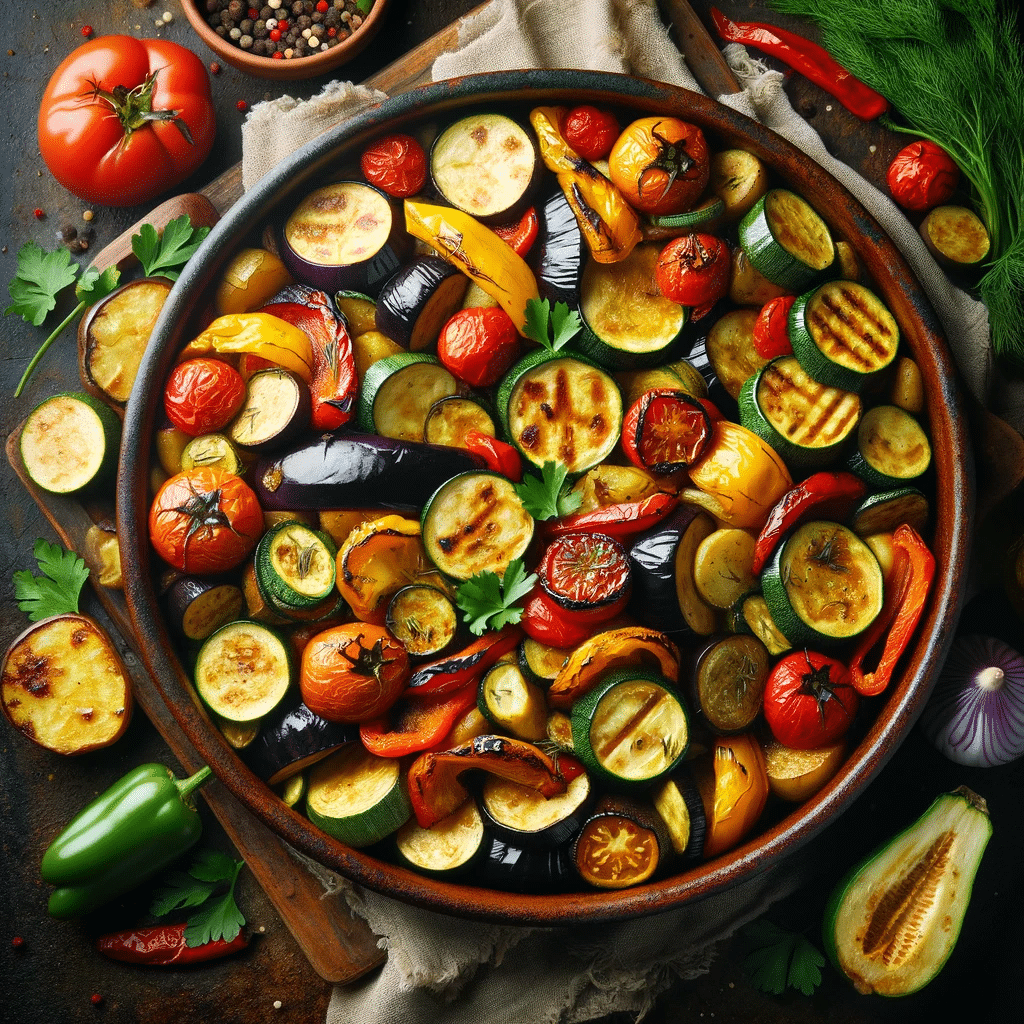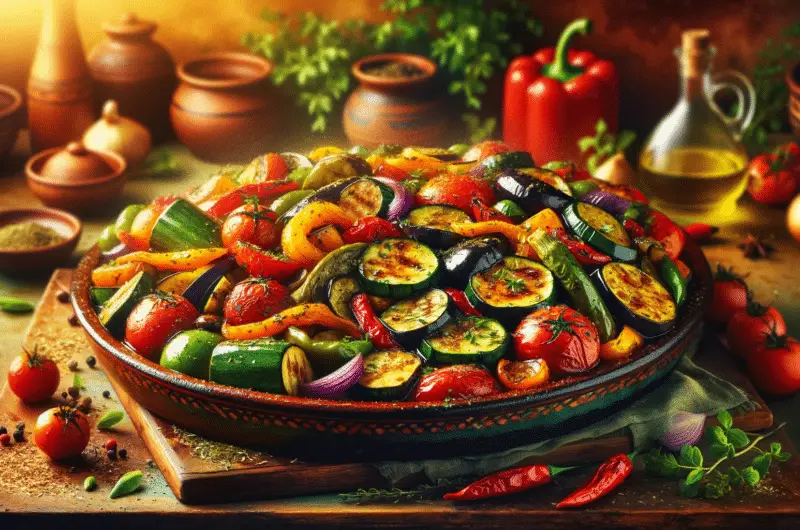Briam is a quintessential Greek dish, epitomizing the simplicity and richness of Mediterranean cuisine. This roasted vegetable delight, originating from the sun-drenched lands of Greece, is a celebration of summer’s bounty. Laden with fresh produce like zucchinis, eggplants, tomatoes, and peppers, Briam is a colorful tapestry of flavors and textures deeply rooted in Greek culinary traditions. Its simplicity, requiring little more than chopping and seasoning, makes it a beloved dish for both home cooks and professional chefs. As we explore Briam, we uncover a recipe and a window into the Greek way of life.

Historical Background
The history of Briam is entwined with the agrarian lifestyle of Greece. This dish evolved out of necessity, using plentiful summer vegetables. While the exact origins are unclear, Briam shares similarities with other Mediterranean dishes like the French Ratatouille or the Turkish Türlü, suggesting a cross-cultural exchange of culinary ideas. Traditionally, Briam was cooked in wood-fired ovens, imparting a unique smokiness to the vegetables. This slow-cooking method was crucial for the dish, allowing flavors to meld and intensify. Over time, as kitchens modernized, Briam adapted to oven roasting, but the dish’s essence remained rooted in its slow-cooked, flavor-enhancing origins.
Ingredients and Variations
Central to Briam are the vegetables. Eggplants and zucchinis offer a meaty texture, while bell peppers add sweetness. Fresh or canned tomatoes bring acidity and moisture, essential for the stewing process. Onions and garlic form the flavor base, with olive oil tying all ingredients together with its rich, fruity notes. Seasonings are simple – salt, pepper, and perhaps a hint of oregano or thyme.
In different regions of Greece, Briam takes on various forms. Some versions include potatoes for heartiness, while others might feature a splash of wine for added depth. On the island of Crete, a touch of cinnamon or allspice is common, showcasing the island’s unique culinary flair. Modern interpretations of Briam have also emerged, incorporating unconventional vegetables like sweet potatoes or adding cheese for richness.
Culinary Techniques
Preparing Briam is a lesson in patience and simplicity. The process begins with slicing the vegetables. The key is uniformity – ensuring each piece is roughly the same size for even cooking. Once sliced, the vegetables are layered in a baking dish, traditionally overlapping, almost like a vegetable mosaic.
Seasoning is next. A generous drizzle of olive oil and a sprinkling of salt, pepper, and herbs are all that’s needed. Some cooks prefer to mix the vegetables with the seasonings in a separate bowl before arranging them in the dish, ensuring an even coat.
The baking process is slow and low. The dish is usually covered with foil and placed in a preheated oven. This allows the vegetables to stew in their juices, concentrating the flavors. Halfway through, the foil is removed to allow the top layer to caramelize, adding a delightful textural contrast.
The exact baking time varies, but the goal is always the same – tender vegetables that have absorbed the herby, olive oil-laden sauce. The slow roasting not only melds flavors but also preserves the individual integrity of each vegetable.
Nutritional Information
Briam is a nutritional powerhouse, aligning with the health-promoting principles of the Mediterranean diet. The vegetables provide a plethora of vitamins and minerals. Eggplants and zucchinis are fiber-rich and low in calories, promoting digestive health. Tomatoes are an excellent source of antioxidants like lycopene, which benefit heart health.
Olive oil, a central component of Briam, is celebrated for its monounsaturated fats, known to improve cholesterol levels and reduce the risk of heart disease. The dish is inherently vegan and gluten-free, catering to various dietary needs. However, its high vegetable content means it’s lower in protein, so those seeking a more balanced meal might consider pairing it with a protein source, such as Greek yogurt or feta cheese.
Serving Suggestions
Briam can be served in various ways, making it a versatile addition to any meal. As a main course, it pairs wonderfully with crusty bread or rice, soaking up the rich, flavorful juices. As a side, it complements grilled meats or fish, adding a healthy and flavorful dimension to the meal.
Garnishing Briam with fresh herbs like parsley or dill can add a burst of freshness. A sprinkle of feta cheese or a dollop of Greek yogurt can also enhance the dish, adding a creamy texture and tangy flavor.
Cultural Significance
In Greek culture, Briam is more than just a dish; it represents familial bonds and communal dining. Often prepared in large quantities, it’s a staple at family gatherings and festive occasions. This dish showcases the Greek ethos of using simple, fresh ingredients to create nourishing, flavorful meals, embodying the spirit of Greek hospitality.
Personal Stories and Testimonials
Greek chefs often reminisce about Briam as a childhood staple, a dish that evokes memories of family and tradition. Many recall the anticipation of opening the oven to a fragrant, colorful array of vegetables, a reminder of summer’s generosity. Home cooks take pride in their family recipes, each with a personal twist, and pass down what to serve with briamed through generations.
What to serve with Briam?
Briam, a traditional Greek dish featuring a medley of roasted vegetables, pairs well with various side dishes and accompaniments. Here are some suggestions:
- Fresh Bread: A loaf of crusty bread, like a baguette or sourdough, is perfect for soaking up the delicious olive oil and vegetable juices.
- Rice or Quinoa: Serve Briam over a bed of fluffy rice or quinoa for a hearty meal. This can be especially good if you want to add a bit more substance to the dish.
- Greek Salad: A classic Greek salad with fresh tomatoes, cucumbers, olives, feta cheese, and a tangy dressing complements the flavors of Briam beautifully.
- Grilled Meat or Fish: For those who aren’t vegetarian, grilled chicken, lamb, or fish make an excellent protein addition to the meal.
- Tzatziki Sauce: This yogurt-based sauce, flavored with cucumber and garlic, is a refreshing accompaniment to the roasted vegetables.
- Lentils or Chickpeas: Add a side of seasoned lentils or chickpeas for a protein boost. This is also a great vegetarian or vegan option.
- Feta Cheese: Crumbling some feta cheese over the Briam adds a salty, creamy element that pairs well with the vegetables.
- Roasted Potatoes: While Briam contains potatoes, serving it with extra crispy roasted potatoes can be delightful for potato lovers.
- Wine: A glass of crisp white wine or a light red, such as Pinot Noir, can complement the dish’s flavors.
Remember, the key is to balance the flavors and textures with your sides, enhancing the enjoyment of the Briam without overpowering it.

